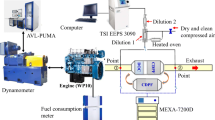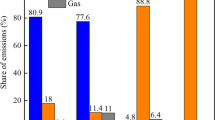Abstract
In this study, the properties of diesel particulate filter (DPF) structures were analyzed in terms of the particulate matter (PM) regeneration of the catalyzed DPF (cDPF) and the exhaust gas reduction efficiency. The performance of the cDPF in combination with a diesel oxidation catalyst was verified by measuring the balance point temperature (BPT) and by conducting world harmonized transient cycle (WHTC)/world harmonized stationary cycle (WHSC)-mode testing using a heavy-duty diesel engine bench. The BPT measurement results (238 °C) showed that, compared with the symmetric cDPF, the asymmetric cDPF exhibited better PM regeneration properties. Additionally, it demonstrated excellent performance in terms of fuel efficiency and reduction efficiency for the total hydrocarbons, carbon monoxide, and PM in exhaust gases. The NO, NO2, and NOx concentrations were analyzed in real time on stream during the cold-WHTC, hot-WHTC, and WHSC mode tests, and the NO2/NOx ratio was confirmed according to the cDPF structure. This study indicates the possibility of develo** a stable diesel exhaust after-treatment system via passive regeneration by improving the BPT performance, exhaust gas reduction efficiency, and NO2/NOx ratio according to the structure of the cDPF.
Similar content being viewed by others
Abbreviations
- CPSI:
-
cells per square inch, cell/in2
- D:
-
diameter, inch
- L:
-
length, inch
- V:
-
volume, liter
- CTE:
-
coefficient of thermal expansion, m/(m·K)
- BPT:
-
balance point temperature, °C
References
Allansson, R., Blakeman, P. G., Cooper, B. J., Hess, H., Silcock, P. J. and Walker, A. P. (2002). Optimising the low temperature performance and regeneration efficiency of the continuously regenerating diesel particulate filter (CR-DPF) system. SAE Paper No. 2002-01-0428.
Aravelli, K. and Heibel, A. (2007). Improved lifetime pressure drop management for Robust Cordierite (RC) filters with Asymmetric Cell Technology (ACT). SAE Paper No. 2007-01-0920.
Bardon, S., Bouteiller, B., Bonnail, N., Girot, P., Gleize, V., Oxarango, L., Higelin, P., Michelin, J., Schuerholz, S. and Terres, F. (2004). Asymmetrical channels to increase DPF lifetime. SAE Paper No. 2004-01-0950.
Caliskan, H. and Mori, K. (2017). Environmental, enviroeconomic and enhanced thermodynamic analyses of a diesel engine with diesel oxidation catalyst (DOC) and diesel particulate filter (DPF) after treatment systems. Energy, 128, 128–144.
Calvert, J. G., Heywood, J. B., Sawyer, R. F. and Seinfeld, J. H. (1993). Achieving acceptable air quality: Some reflections on controlling vehicle emissions. Science 261, 5117, 37–45.
Charterjee, D., Burkhardt, T., Rappe, T., Güthenke, A. and Weibel, M. (2009). Numerical simulation of DOC+DPF+SCR systems: DOC influence on SCR performance. SAE Int. J. Fuels Lubricants 1, 1, 440–451.
Choi, B., Lee, K. and Son, G. (2020). Review of recent after-treatment technologies for de-NOx process in diesel engines. Int. J. Automotive Technology 21, 6, 1597–1618.
Giechaskiel, B., Mamakos, A., Andersson, J., Dilara, P., Martini, G., Schindler, W. and Bergmann, A. (2012). Measurement of automotive nonvolatile particle number emissions within the European legislative framework: A review. Aerosol Science and Technology 46, 7, 719–749.
Guan, B., Zhan, R., Lin, H., and Huang, Z. (2015). Review of the state-of-the-art of exhaust particulate filter technology in internal combustion engines. J. Environmental Management, 154, 225–258.
Iwata, H., Konstandopoulos, A., Nakamura, K, Ogiso, A., Ogyu, K., Shibata, T. and Ohno, K. (2015). Further experimental study of asymmetric plugging layout on DPFs: Effect of wall thickness on pressure drop and soot oxidation. SAE Paper No. 2015-01-1016.
Johnson, B. T. (2008). Diesel engine emissions and their control: An overview. Platinum Metals Review 52, 1, 23–37.
Johnson, T. V. (2009). Review of diesel emissions and control. Int. J. Engine Research 10, 5, 275–285.
Khair, M. K. (2003). A review of diesel particulate filter technologies. SAE Technical Paper No. 2003-01-2303.
Kim, C. S., Schmid, M., Schmieg, S. J., Tan, J. and Li, W. (2011). The effect of Pt-Pd ratio on oxidation catalysts under simulated diesel exhaust. SAE Paper No. 2011-01-1134.
Kim, M., Oh, J. and Lee, C. (2018). Study on combustion and emission characteristics of marine diesel oil and water-in-oil emulsified marine diesel oil. Energies 11, 7, 1830.
Konstandopoulos, A. G. and Kostoglou, M. (2014). Analysis of asymmetric and variable cell geometry wall-flow particulate filters. SAE Int. J. Fuels Lubricants 7, 2, 489–495.
Kubsh, J. (2017). Diesel retrofit technologies and experience for on-road and off-road vehicles. Int. Council of Clean Transportation (ICCT).
Lisi, L., Landi, G. and Di Sarli, V. (2020). The issue of soot-catalyst contact in regeneration of catalytic diesel particulate filters: A critical review. Catalysts 10, 11, 1307.
Loomis, D., Huang, W. and Chen, G. (2014). The International Agency for Research on Cancer (IARC) evaluation of the carcinogenicity of outdoor air pollution: Focus on China. Chinese J. Cancer 33, 4, 189.
Maunula, T., Matilainen, P., Louhelainen, M., Juvonen, P. and Kinnunen, T. (2007). Catalyzed particulate filters for mobile diesel applications. SAE Paper No. 2007-01-0041.
Oh, D. K, Lee, Y. J., Lee, K. Y. and Park, J. S. (2020). Nitrogen monoxide and soot oxidation in diesel emissions with platinum-tungsten/titanium dioxide catalysts: Tungsten loading effect. Catalysts 10, 11, 1283.
Ohno, K., Shimato, K., Taoka, N., Santae, H., Ninomiya, T., Komori, T. and Salvat, O. (2000). Characterization of SiC-DPF for passenger car. SAE Paper No. 2000-01-0185.
Prasad, R. and Bella, V. R. (2010). A review on diesel soot emission, its effect and control. Bulletin of Chemical Reaction Engineering & Catalysis 5, 2, 69.
Silverman, D. T., Samanic, C. M., Lubin, J. H., Blair, A. E., Stewart, P. A., Vermeulen, R., Coble, J. B., Rothman, N, Schleiff, P. L., Travis, W. D., Ziegler, R. G., Wacholder, S. and Attfield, M. D. (2012). The diesel exhaust in miners study: A nested case-control study of lung cancer and diesel exhaust. J. National Cancer Institute 104, 11, 855–868.
Southward, B. W. and Basso, S. (2009). An investigation into the NO2-decoupling of catalyst to soot contact and its implications for catalysed DPF performance. SAE Int. J. Fuels Lubricants 1, 1, 239–251.
Southward, B. W., Basso, S. and Pfeifer, M. (2010). On the development of low PGM content direct soot combustion catalysts for diesel particulate filters. SAE Paper No. 2010-01-0558.
Tang, T., Zhang, J., Cao, D., Shuai, S. and Zhao, Y. (2014). Experimental study on filtration and continuous regeneration of a particulate filter system for heavy-duty diesel engines. J. Environmental Sciences 26, 12, 2434–2439.
Taoka, N, Ohno, K., Hong, S., Sato, H., Yoshida, Y. and Komori, T. (2001). Effect of SiC-DPF with high cell density for pressure loss and regeneration. SAE Paper No. 2001-01-0191.
Wang, Y., Pan, Y., Su, C., Srinivasan, A., Gong, J. and Kamp, C. J. (2018). Performance of asymmetric particulate filter with soot and ash deposits: Analytical solution and its application. Industrial & Engineering Chemistry Research 57, 46, 15846–15856.
**ao, G., Li, B., Tian, H., Leng, X. and Long, W. (2020). Numerical study on flow and pressure drop characteristics of a novel type asymmetric wall-flow diesel particulate filter. Fuel, 267, 117148.
Zhang, J., Lou, D., Sun, Y., Tan, P., Hu, Z. and Huang, C. (2018). Effects of DOC and CDPF catalyst composition on emission characteristics of light-duty diesel engine with DOC+CDPF+SCR system. SAE Paper No. 2018-01-0337.
Zhu, S., Ding, S., **, H., Li, Q. and Wang, R. (2007). Preparation and characterization of SiC/cordierite composite porous ceramics. Ceramics Int. 33, 1, 115–118.
Acknowledgement
This research was funded by the Center for Environmentally Friendly Vehicle (CEFV) as the Global-Top Project of the Ministry of Environment, Korea (KMOE).
Author information
Authors and Affiliations
Corresponding author
Additional information
Publisher’s Note
Springer Nature remains neutral with regard to jurisdictional claims in published maps and institutional affiliations.
Rights and permissions
About this article
Cite this article
Oh, Dk., Ko, A., Woo, Y. et al. Passive Regeneration Characteristics of a DOC/Asymmetric-CDPF System for Heavy-Duty Diesel Engines. Int.J Automot. Technol. 23, 471–479 (2022). https://doi.org/10.1007/s12239-022-0043-9
Received:
Revised:
Accepted:
Published:
Issue Date:
DOI: https://doi.org/10.1007/s12239-022-0043-9




